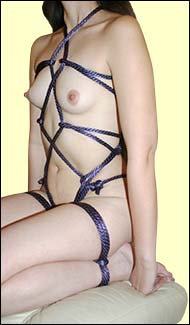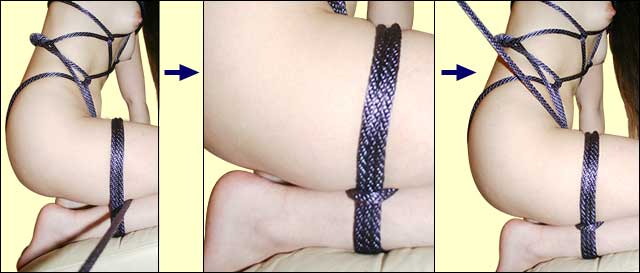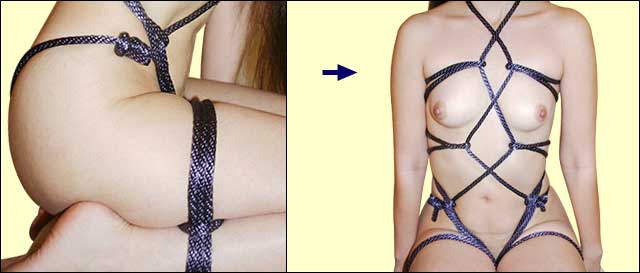How to Tie a Rope Harness, Part II
As promised, part II of the rope harness tutorial, in which the reason Tacit likes using longer pieces of rope is revealed.
As before, unless you work in a place where women in bondage is considered passé, this link is totally not even close to being work-safe. IT Morlocks, cave behind the server room, dragging you down never to see the light of day again...you know the drill.


Part 2: Making a Frog Tie

The picture to the left shows why I like to use longer pieces of rope. The longer piece allows me to finish off the rope harness with other ties, such as the one shown here, which is a lot of fun because it prevents the bound person from being able to stand.
Of course, you'll only want to do this with someone capable of kneeling in this position; some people find this position quickly becomes fatiguing, so it pays to be careful. (As my old Aikido sensei used to say, "Americans have bad knees.) If your partner becomes fatigued or uncomfortable, remove the tie.
Many people who see a basic karada wonder "What's the point? You've tied someone up, but in a way that doesn't restrict freedom of motion! What's te point of being tied up if you aren't restrained?"
The basic karada feels absolutely wonderful; the ropes have a way of moving against sensitive parts of the body when the person who's bound moves. More than that, though, the karada is a good foundation for doing other forms of bondage that do limit the bound person's mobility, one of which is the frog tie.
The purpose of the frog tie is to prevent a person from rising. It keeps the person kneeling and bent over, which is a wonderful position for all sorts of things, from flogging to sex.
You don't actually need to use a long piece of rope for this. You can, if you choose, use a shorter piece of rope to make the karada, then use two 10' lengths of rope, one on each side, to do the frog tie. This tutorial will show you how to do the frog tie using a single 40' piece of rope, but the process is the same if you were to use two separate pieces of rope (one on each leg); you'd start by wrapping one end of the rope around the karada, then follow these instructions.
So, without further ado, let's make a frog tie!
First, have your subject kneel on a soft surface. Take the end of the rope left over from doing the wrap with the karada (or the end of a new piece of rope youve wrapped around the karada), and bring it down between your partner's legs. Then pass it under the person's leg and up around the leg, as these pictures show. (The right-hand picture is a closeup of the center picture.)

Easy, right? Keep wrapping the rope around the person's leg like this several more times. Don't wrap tightly; the rope should only just be snug. We'll adjust the tightness later.
When you've wrapped the rope around several times, then bring it between the person's upper and lower leg, as the picture shows. Pass it around all the wrappings and back between the person's upper and lower leg again. At this point, you'll adjust how tight the wrappings around the leg are; the tighter you pull the loop of rope around the wrappings, the tighter they'll be.
From there, take the end of the rope up along the person's inner thigh...it sounds complicated, but the photos below should show you that it's quite simple.

Now you're almost done. Just take whatever amount of rope is left at the end and wrap it around and around the lower part of the karada where it comes across your partner's butt. When you've reached the end, just tuck the last bit of rope underneath the wrap, and that's it!

From here, a world of opportunity awaits. Your partner can't rise, and is most comfortable on hands and knees, so you're probably already thinking of lots of things you can do at this point. I like the way this position makes a person's backside nicely presented for a flogging, and it's a great position for all kinds of sexual fun.
When you have someone bound this way, it's important to take care not to cut off circulation, and to make sure that the person you have tied up doesn't become excessively fatigued. Many people can't stay in this position indefinitely.
The ropes that wrap around your partner's legs should be loose enough so that you can slip a finger beneath them, so as not to prevent blood flow. monitor your partner; if his or her legs become cold, then you may have tied the ropes too tightly, and you should release them. Also, if the person becomes uncomfortable or experiences leg cramps, you should remove the ropes. Be careful and pay attention, and you'll probably find tht this type of bondage is a lot of fun.
EDIT: Part one of the tutorial is here, also not even close to being work-safe.
As before, unless you work in a place where women in bondage is considered passé, this link is totally not even close to being work-safe. IT Morlocks, cave behind the server room, dragging you down never to see the light of day again...you know the drill.


Part 2: Making a Frog Tie

The picture to the left shows why I like to use longer pieces of rope. The longer piece allows me to finish off the rope harness with other ties, such as the one shown here, which is a lot of fun because it prevents the bound person from being able to stand.
Of course, you'll only want to do this with someone capable of kneeling in this position; some people find this position quickly becomes fatiguing, so it pays to be careful. (As my old Aikido sensei used to say, "Americans have bad knees.) If your partner becomes fatigued or uncomfortable, remove the tie.
Many people who see a basic karada wonder "What's the point? You've tied someone up, but in a way that doesn't restrict freedom of motion! What's te point of being tied up if you aren't restrained?"
The basic karada feels absolutely wonderful; the ropes have a way of moving against sensitive parts of the body when the person who's bound moves. More than that, though, the karada is a good foundation for doing other forms of bondage that do limit the bound person's mobility, one of which is the frog tie.
The purpose of the frog tie is to prevent a person from rising. It keeps the person kneeling and bent over, which is a wonderful position for all sorts of things, from flogging to sex.
You don't actually need to use a long piece of rope for this. You can, if you choose, use a shorter piece of rope to make the karada, then use two 10' lengths of rope, one on each side, to do the frog tie. This tutorial will show you how to do the frog tie using a single 40' piece of rope, but the process is the same if you were to use two separate pieces of rope (one on each leg); you'd start by wrapping one end of the rope around the karada, then follow these instructions.
So, without further ado, let's make a frog tie!
First, have your subject kneel on a soft surface. Take the end of the rope left over from doing the wrap with the karada (or the end of a new piece of rope youve wrapped around the karada), and bring it down between your partner's legs. Then pass it under the person's leg and up around the leg, as these pictures show. (The right-hand picture is a closeup of the center picture.)

Easy, right? Keep wrapping the rope around the person's leg like this several more times. Don't wrap tightly; the rope should only just be snug. We'll adjust the tightness later.
When you've wrapped the rope around several times, then bring it between the person's upper and lower leg, as the picture shows. Pass it around all the wrappings and back between the person's upper and lower leg again. At this point, you'll adjust how tight the wrappings around the leg are; the tighter you pull the loop of rope around the wrappings, the tighter they'll be.
From there, take the end of the rope up along the person's inner thigh...it sounds complicated, but the photos below should show you that it's quite simple.

Now you're almost done. Just take whatever amount of rope is left at the end and wrap it around and around the lower part of the karada where it comes across your partner's butt. When you've reached the end, just tuck the last bit of rope underneath the wrap, and that's it!

From here, a world of opportunity awaits. Your partner can't rise, and is most comfortable on hands and knees, so you're probably already thinking of lots of things you can do at this point. I like the way this position makes a person's backside nicely presented for a flogging, and it's a great position for all kinds of sexual fun.
When you have someone bound this way, it's important to take care not to cut off circulation, and to make sure that the person you have tied up doesn't become excessively fatigued. Many people can't stay in this position indefinitely.
The ropes that wrap around your partner's legs should be loose enough so that you can slip a finger beneath them, so as not to prevent blood flow. monitor your partner; if his or her legs become cold, then you may have tied the ropes too tightly, and you should release them. Also, if the person becomes uncomfortable or experiences leg cramps, you should remove the ropes. Be careful and pay attention, and you'll probably find tht this type of bondage is a lot of fun.
EDIT: Part one of the tutorial is here, also not even close to being work-safe.